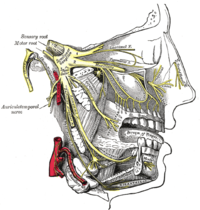
Photo from wikipedia
Aggressive pheochromocytomas and paragangliomas (PPGLs) are difficult to treat, and molecular targeting is being increasingly considered, but with variable results. This study investigates established and novel molecular-targeted drugs and chemotherapeutic… Click to show full abstract
Aggressive pheochromocytomas and paragangliomas (PPGLs) are difficult to treat, and molecular targeting is being increasingly considered, but with variable results. This study investigates established and novel molecular-targeted drugs and chemotherapeutic agents for the treatment of PPGLs in human primary cultures and murine cell line spheroids. In PPGLs from 33 patients, including 7 metastatic PPGLs, we identified germline or somatic driver-mutations in 79% of cases, allowing us to assess potential differences in drug responsivity between pseudohypoxia-associated cluster 1- (n=10) and kinase signaling-associated cluster 2-related (n=14) PPGL primary cultures. Single anti-cancer drugs were either more effective in cluster 1 (cabozantinib, selpercatinib, 5-FU) or similarly effective in both clusters (everolimus, sunitinib, alpelisib, trametinib, niraparib, entinostat, gemcitabine, AR-A014418, high-dose zoledronic acid). High-dose estrogen and low-dose zoledronic acid were the only single substances more effective in cluster 2. Neither cluster 1- nor cluster 2-related patient primary cultures responded to HIF-2α inhibitors, temozolomide, dabrafenib, or octreotide. We showed particular efficacy of targeted combination treatments (cabozantinib/everolimus, alpelisib/everolimus, alpelisib/trametinib) in both clusters, with higher efficacy of some targeted combinations in cluster 2 and overall synergistic effects (cabozantinib/everolimus, alpelisib/trametinib) or synergistic effects in cluster 2 (alpelisib/everolimus). Cabozantinib/everolimus combination therapy, gemcitabine, and high-dose zoledronic acid appear to be promising treatment options with particularly high efficacy in SDHB-mutant and metastatic tumors. In conclusion, only minor differences regarding drug responsivity were found between cluster 1 and cluster 2: some single anti-cancer drugs were more effective in cluster 1 and some targeted combination treatments were more effective in cluster 2.
Journal Title: Endocrine-related cancer
Year Published: 2022
Link to full text (if available)
Share on Social Media: Sign Up to like & get
recommendations!